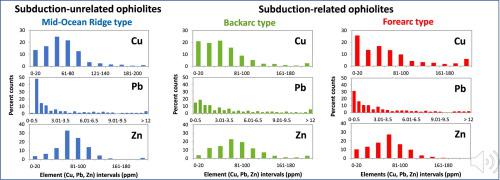Gondwana Research ( IF 6.1 ) Pub Date : 2022-05-18 , DOI: 10.1016/j.gr.2022.05.008 Harald Furnes , Yildirim Dilek , Ekaterina S. Kiseeva

|
We present a global synthesis of Cu, Zn, Pb and Ga contents of mafic dike complexes and volcanic rocks associated with 259 ophiolites, ranging in age from Archaean throughout the Phanerozoic. These ophiolites are geochemically classified as subduction-unrelated and subduction-related with various sub-categories, as defined in Dilek and Furnes (2011). The subduction-unrelated ophiolites include Mid-Ocean Ridge (MOR), and Rift, Continental Margin and Plume type ophiolites, collectively grouped as the R/CM/P sub-category. The subduction-related ophiolites include Backarc (BA), Forearc (FA), Backarc to Forearc (BA-FA), and Volcanic Arc (VA) sub-categories. Compositional distribution of these elements in different ophiolite sub-categories show that Zn and Ga patterns are largely uniform and unrelated to the tectonic setting, whereas Cu and Pb patterns show significant variations. Average copper concentrations progressively increase from subduction-related ophiolites to R/CM/P and MOR. Although less pronounced, lead shows a similar increase in average concentrations from subduction zone environments to MOR, with rather irregular patterns for the R/CM/P and VA types. Mafic subunits in analysed ophiolites define similar trends for Cu and Pb. The mafic subunits, comprising alkaline basalts, mid-ocean ridge basalts (MORB), island arc tholeiites (IAT) and boninites, define a progressive shift towards increasing proportions of low concentrations of Cu and Pb in the listed order. To constrain the large variations in the contents of the given elements, we applied petrogenetic modelling of glass analyses. Petrogenetic modelling of the MgO versus Cu, Zn, Pb and Ga distributions in modern MORB show a scatter that can be explained by different degrees of fractional crystallization (20 – 80%) of primitive MORB lavas. In support of previous studies, we find that most erupted MORB lavas are sulphur saturated, whereas primitive boninitic and IAT magmas are S-undersaturated. The trends observed for IAT are in agreement with previous findings that IAT precipitate sulphide only at very high degrees of fractional crystallization, owing to crystallization of magnetite. Boninites are variable and Cu concentration in boninitic glasses indicates that a fraction of them may be S-saturated at relatively low degrees of fractional crystallization. We model two boninitic compositions and achieve S saturation at 15 and 50% fractional crystallization. The observed Pb enrichment in the R/CM/P ophiolites was likely caused by crustal contamination. Mantle sources of mafic magmas of the ophiolites were also enriched in Cu and Pb by a combination of subduction-related processes as reflected in the chalcophile element (Cu and Pb) behavior patterns of various mafic rock types in the ophiolites.
Comparing with in-situ oceanic crust, we conclude that the chalcophile element distribution patterns of Cu, Zn, Pb and Ga in mafic lavas and dikes in ophiolites were ca. 80–90% magmatically controlled by their abundances in the mantle melt sources, partial melting episodes, and extents of fractional crystallisation processes. The remaining 10–20% difference we attribute mainly to alteration processes (predominantly loss), as well as types and amounts of subducted sediments, whose melt products contributed to the melt column above subducting slabs.
中文翻译:

古代和现代洋壳中嗜铜元素(Cu、Zn、Pb)和Ga的分布模式及其来源:岩石成因模拟和全球综合
我们提出了与 259 种蛇绿岩相关的镁铁质岩脉复合体和火山岩的 Cu、Zn、Pb 和 Ga 含量的全球综合,这些蛇绿岩的年龄范围从太古代到显生宙。这些蛇绿岩在地球化学上被分类为与俯冲无关和与俯冲相关的各种子类别,如 Dilek 和 Furnes(2011 年)所定义。与俯冲无关的蛇绿岩包括大洋中脊(MOR)以及裂谷、大陆边缘和羽流型蛇绿岩,统称为 R/CM/P 亚类。与俯冲相关的蛇绿岩包括弧后 (BA)、前弧 (FA)、弧后到前弧 (BA-FA) 和火山弧 (VA) 子类别。这些元素在不同蛇绿岩亚类中的组成分布表明,Zn 和 Ga 模式在很大程度上是均匀的,与构造环境无关,而 Cu 和 Pb 模式显示出显着的变化。平均铜浓度从与俯冲相关的蛇绿岩逐渐增加到 R/CM/P 和 MOR。虽然不那么明显,但铅从俯冲带环境到 MOR 的平均浓度显示出类似的增加,对于 R/CM/P 和 VA 类型具有相当不规则的模式。分析的蛇绿岩中的镁铁质亚基定义了铜和铅的类似趋势。镁铁质亚基包括碱性玄武岩、洋中脊玄武岩 (MORB)、岛弧拉斑玄武岩 (IAT) 和博宁岩,它们定义了按所列顺序逐渐增加低浓度铜和铅的比例。为了限制给定元素含量的巨大变化,我们应用了玻璃分析的岩石生成模型。MgO 与 Cu、Zn、现代 MORB 中的 Pb 和 Ga 分布显示出分散,这可以通过原始 MORB 熔岩的不同程度结晶(20-80%)来解释。为支持先前的研究,我们发现大多数喷发的 MORB 熔岩是硫饱和的,而原始砂砾岩和 IAT 岩浆是硫饱和的。观察到的 IAT 趋势与先前的发现一致,即 IAT 仅在非常高的分级结晶度下沉淀硫化物,这是由于磁铁矿的结晶。Boninite 是可变的,并且 Boninitic 玻璃中的 Cu 浓度表明它们中的一部分可能在相对较低的分级结晶度下是 S 饱和的。我们对两种软硬质合金成分进行建模,并在 15% 和 50% 的分级结晶下实现 S 饱和。在 R/CM/P 蛇绿岩中观察到的 Pb 富集可能是由地壳污染引起的。蛇绿岩镁铁质岩浆的地幔源也通过俯冲相关过程的组合富集了 Cu 和 Pb,这反映在蛇绿岩中各种镁铁质岩石类型的嗜铜元素(Cu 和 Pb)行为模式中。
与原地洋壳相比,我们得出结论,镁铁质熔岩和蛇绿岩脉中的铜、锌、铅和镓的亲铜元素分布模式约为。80-90% 的岩浆受它们在地幔熔体源中的丰度、部分熔融事件和分级结晶过程的程度控制。其余 10-20% 的差异主要归因于蚀变过程(主要是损失),以及俯冲沉积物的类型和数量,其熔体产物促成了俯冲板片上方的熔体柱。



























 京公网安备 11010802027423号
京公网安备 11010802027423号